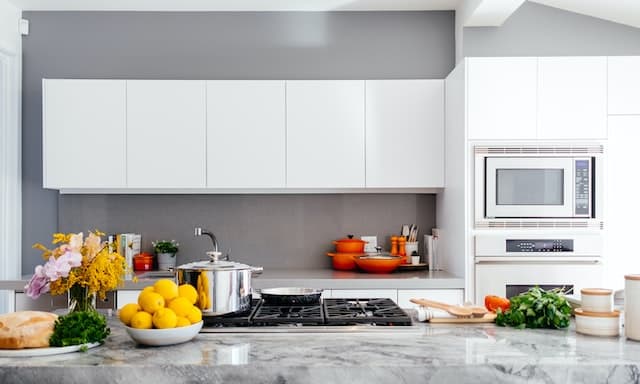
The global pandemic has highlighted the importance of using toxin-free materials at home. With traditional cleaners shifting toward safer alternatives, it's important to examine other stress-causing chemicals in our daily environment. Read on to learn about the impact of chemicals on our bodies and how you can take steps to create a chemical-free home and live a more eco-friendly lifestyle.
Natural Air and
Plants
Aerosol air fresheners, plug-ins, and scented candles have long been popular choices for cleansing the air in our homes. However, they contain chemicals that negatively impact our health, such as volatile organic compounds (VOCs). Exposure to these compounds can cause shortness of breath, headaches, dizziness, skin problems, nausea, irritation in the eyes, nose, and throat, and fatigue. Choosing natural air freshening methods such as opening windows and keeping houseplants around can help reduce your exposure to these harmful compounds. Some plants, like Barberton Daisy, English Ivy, Snake Plant, Chrysanthemum, Spider Plant, Aloe Vera, Broad Lady Palm, Red-Edged Dracaena/Dragon Tree, Weeping Fig, and Chinese Evergreen, are better at natural air freshening than others and require little effort to care for.

Toxin-Free
Bedroom
Your bedroom
should be a place of refuge, but your furnishings can cause an allergic
reaction. It's important to control the number of toxins in your bedroom. For
instance, it's best to consider buying a mattress made of dense or natural
materials since traditional mattresses are a hotspot for bacteria. By switching
to natural latex, bamboo, coconut coir, or another natural material, you'll
significantly reduce the risk of an allergic reaction. Additionally, using a
mite-proof mattress and pillow covers and washing your bedding regularly can
help curb dust mites. For hygienic bedding, choose natural fibers like cotton,
bamboo, linen, silk, and wool, which offer superior breathability without
uncomfortable static electricity or skin sensitivity. Furnishing your bedroom
with materials like glass, ceramic, metal, natural wood, or bamboo, and
avoiding plastics and foam-stuffed furniture, will help minimize chemical
toxins.

Toxin-Free
Kitchen
Maintaining a chemical-free home environment also involves being mindful of how you eat and cook. Highly processed foods contain added sugars, preservatives, stabilizers, artificial flavoring, dyes, and other harmful chemicals. The basic ingredients we cook with, like fruits, vegetables, nuts, meats, and dairy, can contain mercury, fertilizer, growth hormones, insecticides, and antibiotics. Organic eating is one way to improve the overall quality of basic ingredients. By choosing organically grown or raised foods, you can rule out synthetic pesticides and fertilizers. While it may not be possible to eliminate all chemical toxins from your diet, making small changes like choosing organic and avoiding farmed fish can make a significant difference.
Toxin-Free Bathroom and Hygiene
The bathroom, and your hygiene
routine, also hide their share of chemical toxins. Aside from the range of
cleaners stashed away under the sink or in the cupboard, consider what you
likely have in the bathroom, things like toothpaste, hand soap, skin care
products, perfumes/colognes/aftershaves, shampoo and conditioner, bath soap or
shower gel, toilet paper, plastic shower curtain, towels and bathmats.
Each of these things have better alternatives. Natural, organic bath, dental, and skin care options are available at your local pharmacy, natural health shop, or online. Toilet paper comes in chemical-free varieties that use a large proportion of recycled paper. As with your bedding, you can purchase towels, bathmats, and shower curtains in natural materials like bamboo or cotton. The possibilities for ridding your bathroom of unnecessary chemicals are not only easy, but the choices are nearly endless.
Toxin-Free Kids Bedroom
Though last on our list, the kids’ bedroom is arguably essential to detoxify. Aside from bedding and furnishings, a child’s room poses a few additional challenges concerning their extra belongings. Depending on your child's age, you may have playmats on the floor, plastic play furniture, plastic toys, easy-wipe vinyl changing pads, vinyl-covered baby mattresses, and so forth. Their bedding and mattresses are easy to replace, following the same example you set in your room. The plastic and vinyl items may be a little more challenging to replace. You’ll need to find natural materials that are just as easy to maintain and can take a beating. Replacing synthetic playmats with natural rubber is easy, or simply use an untreated rug or carpet made from a natural material. When it comes to the health of your child, toxin-free materials for an eco-friendly baby nursery are always best.

Conclusion
A
home is supposed to be a refuge, but if it’s filled with chemicals causing
health problems for you and your loved ones, it becomes a source of stress and
unhappiness. By creating a chemical
stress-free home, you’re taking
positive steps forward for the well-being of the entire household. Those steps
don’t have to be drastic, and they don’t have to cost a ton of money to achieve
the desired result. What matters here is your health.








